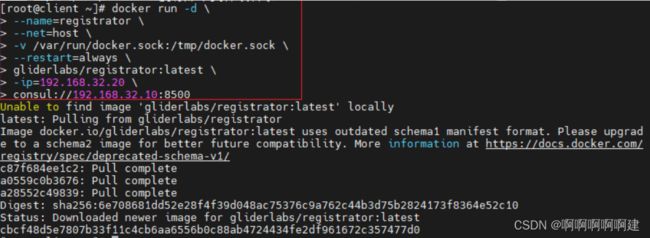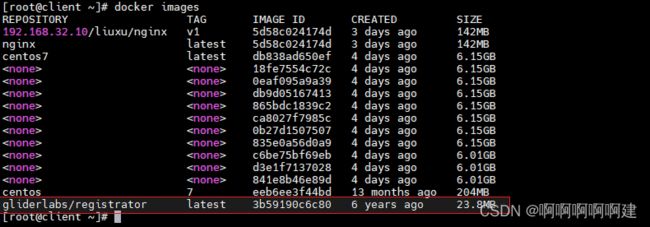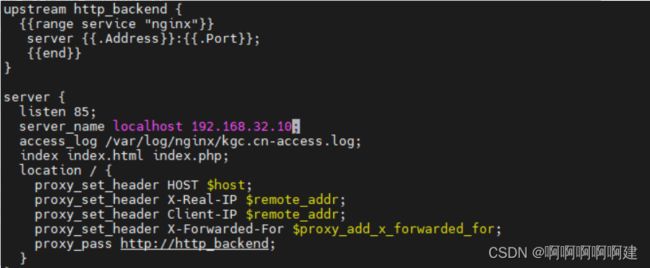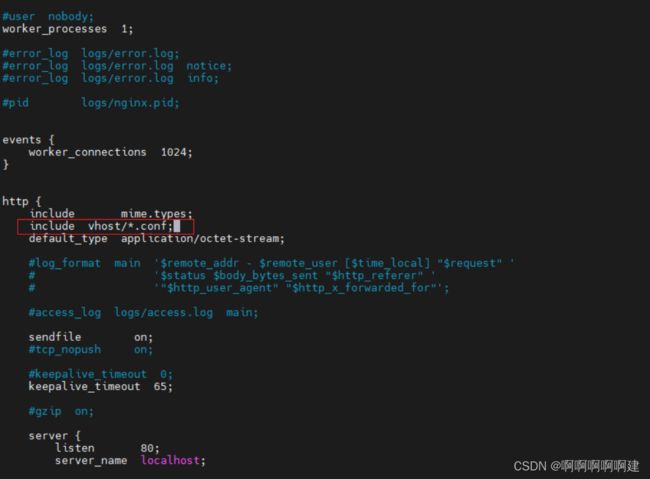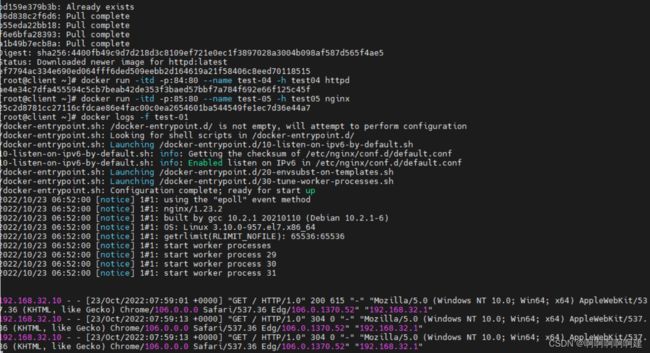Docker容器Consul部署
目录
引言
一、Consul概述
二、Consul特性
三、Consul使用场景
四、搭建Consul集群
1.Consul服务器
2.通过httpd api 获取集群信息
3. 容器服务自动加入consul集群
4.在consul服务器上查看服务
5.安装 consul-template
准备 template nginx 模板文件
6. 编译安装nginx
7. 配置 nginx
配置并启动 template
关联nginx 虚拟目录中的子配置文件操作
8. 测试访问代理服务器
引言
Consul是HashiCorp公司退出的开源工具,用于实现分布式系统的服务发现于配置与Docker等轻量级容器可无缝配合
一、Consul概述
- template模板(更新)
- registrator(自动发现)
- 后端每构建出一个容器,会向registrator进行注册,控制consul完成更新操作,consul会触发consul template模板进行热更新
- 核心机制:consul:自动发现、自动更新、为容器提供服务(添加、删除、生命周期)
二、Consul特性
- 1、支持健康检查,允许存储键值对
- 2、基于Golong语言开发,可移植性强
- 3、支持ACL访问控制
三、Consul使用场景
Consul的应用场景包括服务发现、服务隔离、服务配置:
1、服务发现场景中consul作为注册中心,服务地址被注册到consul中以后,可以使用consul提供的dns、http接口查询,consul支持health check。
2、服务隔离场景中consul支持以服务为单位设置访问策略,能同时支持经典的平台和新兴平台,支持tls证书分发,service-to-service加密。
3、服务配置场景中consul提供key-value数据存储功能,并能将变动迅速地通知出去,借助Consul可以实现配置共享,需要读取配置的服务可以从Consul中读取到准确的配置信息。
4、Consul可以帮助系统管理者更清晰的了解复杂系统内部的系统架构,运维人员可以将Consul看成一种监控系统,也可以看成一种资产(资源)管理系统。
四、搭建Consul集群
建立Consul服务
每个提供服务的节点上都要部署和运行Consul和agent
Consul agent有两种运行模式
Server
Client
Server和Client只是Consul集群层面的区分,与搭建再Cluster之上的应用服务无关
服务器nginx:192.168.32.10 Nginx 、Consul、 Consul-template
服务器docker:192.168.32.20 Docker-ce、registrator(自动发现、注册的组件)
template 模板(更新)
registrator(自动发现)
后端每构建出一个容器,会向registrator进行注册,控制consul 完成更新操作,consul会触发consul template模板进行热更新
核心机制:consul :自动发现、自动更新,为容器提供服务(添加、删除、生命周期辅助功能)
1.Consul服务器
mkdir /root/consul
cp consul_0.9.2_linux_amd64.zip /root/consul
cd /root/consul
unzip consul_0.9.2_linux_amd64.zip
mv consul /usr/bin
consul agent \
-server \
-bootstrap \
-ui \
-data-dir=/var/lib/consul-data \
-bind=192.168.32.10 \
-client=0.0.0.0 \
-node=consul-server01 &> /var/log/consul.log &
consul members
consul info | grep leader
2.通过httpd api 获取集群信息
| curl 127.0.0.1:8500/v1/status/peers | 查看集群server成员 |
|---|---|
| curl 127.0.0.1:8500/v1/status/leader | 集群 Raf leader |
| curl 127.0.0.1:8500/v1/catalog/services | 注册的所有服务 |
| curl 127.0.0.1:8500/v1/catalog/nginx | 查看 nginx 服务信息 |
| curl 127.0.0.1:8500/v1/catalog/nodes | 集群节点详细信息 |
3. 容器服务自动加入consul集群
安装 Gliderlabs/Registrator Gliderlabs/Registrator
可检查容器运行状态自动注册,还可注销 docker 容器的服务 到服务配置中心。
目前支持 Consul、Etcd 和 SkyDNS2。
在 192.168.32.20 节点,执行以下操作:
docker run -d
–name=registrator
–net=host
-v /var/run/docker.sock:/tmp/docker.sock
–restart=always
gliderlabs/registrator:latest
-ip=192.168.32.20
consul://192.168.32.10:8500
systemctl restart docker
docker run -itd -p:81:80 --name test-01 -h test01 nginx
docker run -itd -p:82:80 --name test-02 -h test02 nginx
docker run -itd -p:83:80 --name test-03 -h test03 httpd
docker run -itd -p:84:80 --name test-04 -h test04 httpd
真机访问http://192.168.32.10:8500
此时应该可以发现5个服务
4.在consul服务器上查看服务
curl 127.0.0.1:8500/v1/catalog/services5.安装 consul-template
Consul-Template 是一个守护进程,用于实时查询 Consul 集群信息,
并更新文件系统 上任意数量的指定模板,生成配置文件。更新完成以后,
可以选择运行 shell 命令执行更新 操作,重新加载 Nginx。Consul-Template
可以查询 Consul 中的服务目录、Key、Key-values 等。
这种强大的抽象功能和查询语言模板可以使 Consul-Template 特别适合动态的创建配置文件。
例如:创建 Apache/Nginx Proxy Balancers、Haproxy Backends
准备 template nginx 模板文件
在consul上操作
vim /root/consul/nginx.ctmpl
upstream http_backend {
{{range service "nginx"}}
server {{.Address}}:{{.Port}}; #此处引用的变量会指向后端的地址和端口(动态变化)
{{end}}
}
server {
listen 85;
server_name localhost 192.168.32.10; #反向代理的IP地址(前端展示的NG服务的IP)
access_log /var/log/nginx/kgc.cn-access.log;
index index.html index.php;
location / {
proxy_set_header HOST $host;
proxy_set_header X-Real-IP $remote_addr; #后端真实IP
proxy_set_header Client-IP $remote_addr;
proxy_set_header X-Forwarded-For $proxy_add_x_forwarded_for; #转发地址
proxy_pass http://http_backend;
}
}
6. 编译安装nginx
yum install gcc pcre-devel zlib-devel -ytar zxvf nginx-1.15.9.tar.gz -C /optcd /opt/nginx-1.15.9/
./configure --prefix=/usr/local/nginxmake && make installln -s /usr/local/nginx/sbin/nginx /usr/local/sbin![]()
7. 配置 nginx
vim /usr/local/nginx/conf/nginx.conf
http {
include mime.types; #默认存在的
include vhost/*.conf; ####添加虚拟主机目录(consul动态生成的配置文件就会放在这里)
default_type application/octet-stream;
创建虚拟主机目录
mkdir /usr/local/nginx/conf/vhost
创建日志文件目录
mkdir /var/log/nginx
启动nginx
usr/local/nginx/sbin/nginx配置并启动 template
上传 consul-template_0.19.3_linux_amd64.zip 包到/root 目录下
cp consul-template_0.19.3_linux_amd64.zip /root/
unzip consul-template_0.19.3_linux_amd64.zip
mv consul-template /usr/bin/
关联nginx 虚拟目录中的子配置文件操作
consul-template -consul-addr 192.168.32.10:8500 -template "/root/consul/nginx.ctmpl:/usr/local/nginx/conf/vhost/lx.conf:/usr/local/nginx/sbin/nginx -s reload" --log-level=info
再打开另一个终端
 在Client端
在Client端
再次运行一个nginx容器,查看server nginx配置文件是否自动更新
docker run -itd -p:85:80 --name test-05 -h test05 nginx8. 测试访问代理服务器
是否可以完成代理访问轮询
192.168.32.10
http://192.168.32.10:85/
docker logs -f test-01
docker logs -f test-02
docker logs -f test-05






